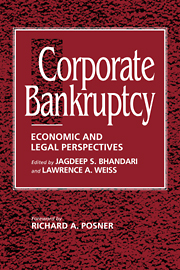Book contents
- Frontmatter
- Contents
- List of tables and figures
- Foreword by the HONORABLE RICHARD A. POSNER
- Preface
- Part I The role of credit
- Part II Bankruptcy as a reflection of the creditors' implicit bargain
- Part III Beyond the basic creditors' bargain
- 9 Bargaining after the fall and the contours of the absolute priority rule
- 10 On the nature of bankruptcy: An essay on bankruptcy sharing and the creditors' bargain
- 11 A simple noncooperative bargaining model of corporate reorganizations
- 12 Commentary on “On the nature of bankruptcy”: bankruptcy, priority, and economics
- 13 Bankruptcy and risk allocation
- 14 The corporate bankruptcy decision
- 15 Bargaining over equity's share in the bankruptcy reorganization of large, publicly held companies
- 16 Bankruptcy resolution: Direct costs and violation of priority of claims
- 17 The costs of conflict resolution and financial distress: Evidence from the Texaco-Pennzoil litigation
- 18 Survey of evidence on business bankruptcy
- Part IV Workouts or bargaining in the shadow of bankruptcy
- Part V Alternatives to bankruptcy and the creditors' bargain
- Part VI Experience of other countries
- Index
13 - Bankruptcy and risk allocation
Published online by Cambridge University Press: 10 December 2009
- Frontmatter
- Contents
- List of tables and figures
- Foreword by the HONORABLE RICHARD A. POSNER
- Preface
- Part I The role of credit
- Part II Bankruptcy as a reflection of the creditors' implicit bargain
- Part III Beyond the basic creditors' bargain
- 9 Bargaining after the fall and the contours of the absolute priority rule
- 10 On the nature of bankruptcy: An essay on bankruptcy sharing and the creditors' bargain
- 11 A simple noncooperative bargaining model of corporate reorganizations
- 12 Commentary on “On the nature of bankruptcy”: bankruptcy, priority, and economics
- 13 Bankruptcy and risk allocation
- 14 The corporate bankruptcy decision
- 15 Bargaining over equity's share in the bankruptcy reorganization of large, publicly held companies
- 16 Bankruptcy resolution: Direct costs and violation of priority of claims
- 17 The costs of conflict resolution and financial distress: Evidence from the Texaco-Pennzoil litigation
- 18 Survey of evidence on business bankruptcy
- Part IV Workouts or bargaining in the shadow of bankruptcy
- Part V Alternatives to bankruptcy and the creditors' bargain
- Part VI Experience of other countries
- Index
Summary
Introduction
Bankrupt business firms distribute property to low-priority investors even though the firms do not fully repay high-priority investors. That bankruptcy in this way alters contractual priorities effectively reallocates among investors the risk of business insolvency. Commentators have roundly criticized such reallocation as an impediment to efficient business practice. Recently, however, a “risk-sharing” defense of bankruptcy reallocation has appeared in both the law and finance literature. Risk-sharing theorists argue that all investors in a business debtor – equity investors and creditors alike – would choose to share the risk of loss from the debtor's insolvency. These theorists surmise that investors cannot agree to share such risk, because a risk-sharing agreement is prohibitively expensive to negotiate. Therefore, the theorists conclude, bankruptcy reallocation furnishes a mutually beneficial hypothetical bargain to which investors would expressly agree but for transaction difficulties.
Though ostensibly plausible, risk-sharing theory must overcome a formidable obstacle: the actual bargain among investors is not silent on how to allocate insolvency risk. That bargain, in the form of equity and creditor contracts, expressly allocates insolvency risk to the low-priority, or “junior,” investors (i.e., to equity investors and general unsecured creditors). Thus bankruptcy reallocation appears to conflict with the parties' express intent.
Moreover, one cannot properly attribute contractual priority to transaction costs. Contractual priority reflects a bargain struck within the network of contracts that comprises every firm. As part of the investors' contractual network, equity investors purchase residual claims subordinate to those of creditors.
- Type
- Chapter
- Information
- Corporate BankruptcyEconomic and Legal Perspectives, pp. 190 - 206Publisher: Cambridge University PressPrint publication year: 1996
- 5
- Cited by



